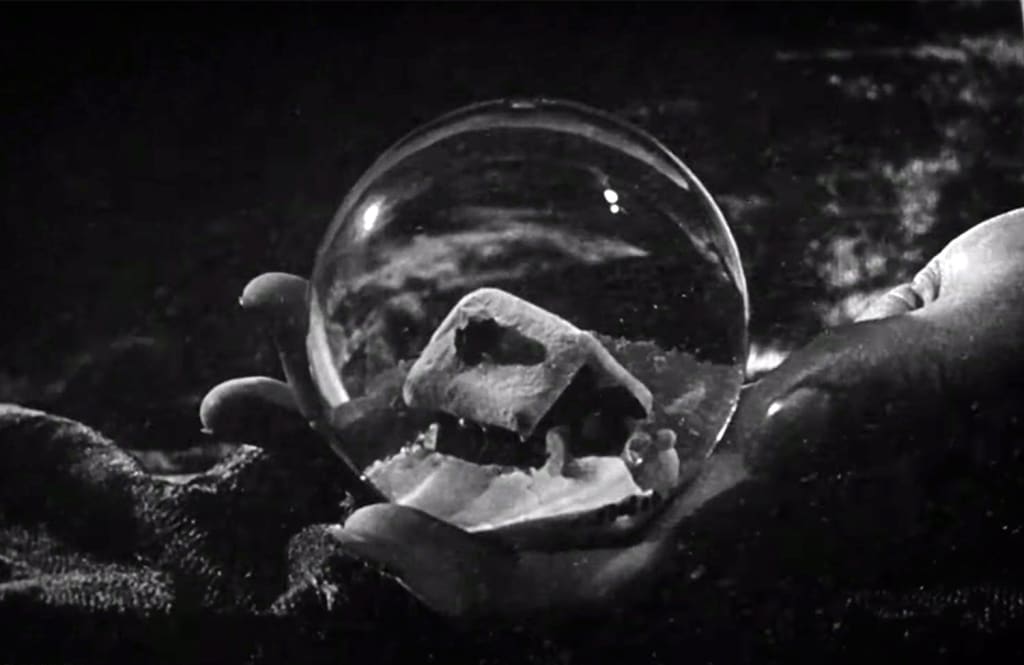Mank (2020): The Mirror Image of Citizen Kane
Greatness In The Making

Recently David Fincher’s “Mank” made me very disappointed because there wasn’t enough Orson Welles in it, however the similarities of “Mank” (2020) and Citizen Kane (1941) were intentionally uncanny from the start. From it’s unique sound profile to its lush black and white cinematography to classic courier typewriting text, Mank is a love letter to the Golden Age of Hollywood and to one of it’s enigmatic screenwriter at the time, Herman Mankiewicz.

Film Synopsis: 1930s Hollywood is reevaluated through the eyes of scathing wit and alcoholic screenwriter Herman J. Mankiewicz as he races to finish “Citizen Kane.”
The film was made more for dramatic purposes than accurate. Starting of the premise of the film was based off a debunked 70’s article claim by film critic Pauline Kael, who says Herman did all the work, Orson did nothing, therefore Herman deserves all the credit.
However this claim was not true. Orson Welles did not have much of a hand in the first drafts, but the later drafts which gave Citizen Kane its form were done by Orson Welles using parts of Herman’s writing and mix together the parts he wanted. Which is part of the reason why Orson Was credited as a co-author and Mankiewicz -Author.
“You cannot capture a man’s life in two hours. All you can hope is to leave an impression of one.”- Mankiewicz
Like any good storyteller you should know what you can and can’t do. You can’t tell an entire life story because there are just too many details. However you can get into telling some of those details leaving an impression of an entire life. This is what bounds Mank (2020) and Citizen Kane (1941). Mank tells the story of Herman Mankiewicz’s time spent on writing one of his greatest works, the screenplay for Citizen Kane and the motivation behind it. While Citizen Kane tells the life story of Charles Foster Kane a man who had it all and his motivation for success.

Mank's Inspiration
Being a natural homage to something that once was, makes it essential for the real life inspiration to take form. There is no greater inspiration than Charles Foster Kane to be the perfect embodiment of a William Randolph Hearst, at the time a powerful business tycoon that owns newsreels and shapes public opinion.
The controversial part of the film isn’t as much as who deserves the screenwriting credit, but how the making of the film Citizen Kane, makes Orson Welles and Herman Mankiewicz an enemy against the Hollywood studio system and William Randolph Hearst. Herman’s brother Joseph is against the making of Citizen Kane, adding that hunting Hearst is a dangerous game.
Authorship
In the craft of writing authorship is always tied to the craftsman’s product. We take pride in our work, human beings are like that. Whenever we see a well renowned name attached to a certain work, it gives the work more value. Why give credit toward someone that didn’t earn it? Credit belongs to where it is rightfully due.
In the beginning the first draft and idea to write about Hearst was Herman Mankiewicz’s. However Mankiewicz signed a contract relinquishing writing credit. Although a argument between the two writers lead Orson to break the contract and give Herman writing credit, credit for the picture. The film portrays Welles as a nefarious evil mustache wearing villain with no sympathy for Herman’s car accident and just wants him to work so that he can steal credit. This was done more for drama than accuracy.
When there is more than one author credit should go to a mix-authorship not primary the writers, but the director, producer, production designers, audio guy, cast and crew, anyone that was a part of the bigger picture. All this couldn’t have been achieved without Welles, the director at the helm. Without a vision for direction There is no way to achieve the final product.
In Citizen Kane, Welles shares a title card with cameraman Greg Toland Orson’s vision combined with Toland’s cinematography helped create this dream to a reality. Also writing credits for Citizen Kane were shared with four other writers, besides Welles. Something that could’ve been more transparent in Mank.

Mavericks United
If there’s one thing that ties Herman Mankiewicz and Orson Welles together that must be the bond of being nonconformist or Mavericks. They are this category for not following the rules, but making up their own. This is the best way to get original ideas. When copying someone else’s you run the risk of lack of imagination and sincerity.
By making Citizen Kane, there was no lack of experimentation when it came to the story and the production of it. The two opposed the Hollywood system and became ostracized for it. Citizen Kane was blacklisted by Hearst’s newsreels and any talk about it in Hollywood was prohibited.
The making Citizen Kane back then is equivalent today of a small time filmmaker making a film attacking a Donald Trump or Michael Bloomberg. Or Seth Rogen making a film about assassinating the North Korean dictator, hence “The Interview”(2014).
Mank Mirroring Kane:
It’s becoming a type of cliché the inception this movie brings, as Mank is a movie within a movie, a film about filmmaking just like Once Upon a time in Hollywood, Hugo, The Disaster artist, Blow Out, Marriage Story, Sunset Blvd and many others. Throughout Mank we see a direct connection of Welles’s classic Citizen Kane.
One part in particular reveals the personal homage behind the shot. It is nearly identical in Mank when an empty bottle Mankiewicz drank and is passed out like a lifeless corpse. This perfectly mirrors that of Charles Foster Kane holding a snow-globe in the opening moments of Citizen Kane when the globe smashes the ground, signifying the end of Kane’s life.
In Citizen Kane, “Rosebud” is uttered by the character Charles Foster Kane on his deathbed, and subsequently becomes a MacGuffin plot device for the rest of the movie. Since Mank explores the writing process for Citizen Kane, it heavily implies that Mankiewicz used “Rosebud” as a Hollywood insider joke on media mogul William Randolph Hearst and his mistress, Davies.
Mank meticulously replicates Citizen Kane’s protagonist by identically embodying a larger than life figure, obscured in enigma, at the pinnacle of his life, who suddenly falls to the lowest depths. Herman Mankiewicz is the head of a family of reporters that helped out in political campaigns. Just like Charles Foster Kane the head of a newsreels who also ran for president.
Just like Citizen Kane’s narrative, “Mank” tells a current black and white story while skipping out of chronological order in the form of flashbacks. “Mank” jumps back and forth between the process of writing the iconic script for Citizen Kane and the inspiration for it, the 1934 governors ball. While Citizen Kane jumps back and forth the life of Charles Foster Kane and the investigation upon meaning of his final words.
Mank’s Greatest Weakness
Mankiewicz’s fatal flaw was his alcoholism which affected his personal relationships and inevitably costed him his life in 1953. But what fueled this flaw was the belief that he wasn’t good enough. He believed he wouldn’t be remembered when he was gone, ironically except for his family, David Fincher and many others admires of cinema. It wasn’t until late 1930’s Mankiewicz believed that the writing of Citizen Kane was his greatest achievement and wanted to be remembered for it.
In one iconic scene in Mank, Welles and Mankiewicz are arguing over screen credit. This caused Orson to outburst in rage and destroy the apartment. This is a reenactment scene from Citizen Kane when Charles Foster Kane also played by Orson Welles destroys the room in a heated argument.
The Tragedy of Mank
Herman Mankiewicz’s story was tragic. He was a alcoholic gambler that disassociated many in his personal and professional life to leave a legacy of his life’s work, ironically. As the story progresses Mankiewicz’s liquor cabinet keeps getting emptier as his self-destructive behavior grows.
Mankiewicz’s assistant says he’s not writing an opera, only he is writing a opera. He’s writing a Shakespeare tragedy full of passion, fear and death. He’s doing something controversial and frowned at by the majority. This did not come free of charge as it costed Mankiewicz his friends, colleagues, status, brother, physical health and sanity.
This tragedy shows the fall of a once highly regarded figure to his death, (figuratively then literally). This figure is a double entendre as in it is not just the fictitious Charles Foster Kane, but the real Herman Mankiewicz. Both men were plagued by tragedy which makes it relatable. We always want to succeed at a goal, nobody wants failure, but sometimes things don’t go as planned. It’s these struggles that makes or breaks us, that defines u s who we are and what we are capable of.

To See or Not to see?
Overall it’s an engaging dramatic biopic for anyone not familiar with Old Hollywood history. Mank says sometimes the right opinion may not be the popular one. A hard point of view to look at if one doesn’t agree.
Even though the film Citizen Kane was banned from all of Hearst’s publications, it was nominated for nine academy awards, won best screenplay and became a blueprint example of how to make a film the right way. The film now a relegated legacy that was printed for the books of history.





Comments
There are no comments for this story
Be the first to respond and start the conversation.